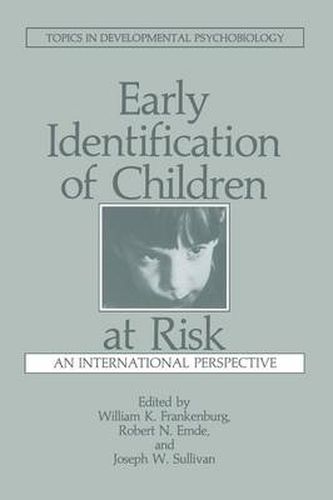Readings Newsletter
Become a Readings Member to make your shopping experience even easier.
Sign in or sign up for free!
You’re not far away from qualifying for FREE standard shipping within Australia
You’ve qualified for FREE standard shipping within Australia
The cart is loading…






This title is printed to order. This book may have been self-published. If so, we cannot guarantee the quality of the content. In the main most books will have gone through the editing process however some may not. We therefore suggest that you be aware of this before ordering this book. If in doubt check either the author or publisher’s details as we are unable to accept any returns unless they are faulty. Please contact us if you have any questions.
This volume contains contributions that are interdisciplinary and inter national. The editors believe this is an especially timely and promising enterprise, for both sources of diversity are needed for improving our abilities to identify the young child at risk and to prevent disability. In terms of diSciplines, the volume brings together papers by health care providers (such as pediatricians and public health nurses) as well as educators and psychologists. Each of these groups works in dissimilar settings and faces dissimilar problems: Health care providers seek sim ple identification procedures for use in busy primary care settings; psy chologists emphasize well-constructed research designs; and educators reflect the need for early identification and education. Each of these spe cialist groups has something to offer the other, but too often each tends to limit its publications and readings to its own discipline, thus failing to capitalize on a wider scope. of knowledge and practice. We hope that this selection of papers will allow all readers addressing the early iden tification of children at risk to generate a more integrated interdiscipli nary perspective. We also hope this volume reflects the sense of excitement that we feel from a sharing of international perspectives. There is no single ap proach to the early identification of children at risk that is universally applicable to all countries. In addition, approaches within each country vary because of availability of financial and human resources and dif fering expectations of local communities.
$9.00 standard shipping within Australia
FREE standard shipping within Australia for orders over $100.00
Express & International shipping calculated at checkout
This title is printed to order. This book may have been self-published. If so, we cannot guarantee the quality of the content. In the main most books will have gone through the editing process however some may not. We therefore suggest that you be aware of this before ordering this book. If in doubt check either the author or publisher’s details as we are unable to accept any returns unless they are faulty. Please contact us if you have any questions.
This volume contains contributions that are interdisciplinary and inter national. The editors believe this is an especially timely and promising enterprise, for both sources of diversity are needed for improving our abilities to identify the young child at risk and to prevent disability. In terms of diSciplines, the volume brings together papers by health care providers (such as pediatricians and public health nurses) as well as educators and psychologists. Each of these groups works in dissimilar settings and faces dissimilar problems: Health care providers seek sim ple identification procedures for use in busy primary care settings; psy chologists emphasize well-constructed research designs; and educators reflect the need for early identification and education. Each of these spe cialist groups has something to offer the other, but too often each tends to limit its publications and readings to its own discipline, thus failing to capitalize on a wider scope. of knowledge and practice. We hope that this selection of papers will allow all readers addressing the early iden tification of children at risk to generate a more integrated interdiscipli nary perspective. We also hope this volume reflects the sense of excitement that we feel from a sharing of international perspectives. There is no single ap proach to the early identification of children at risk that is universally applicable to all countries. In addition, approaches within each country vary because of availability of financial and human resources and dif fering expectations of local communities.